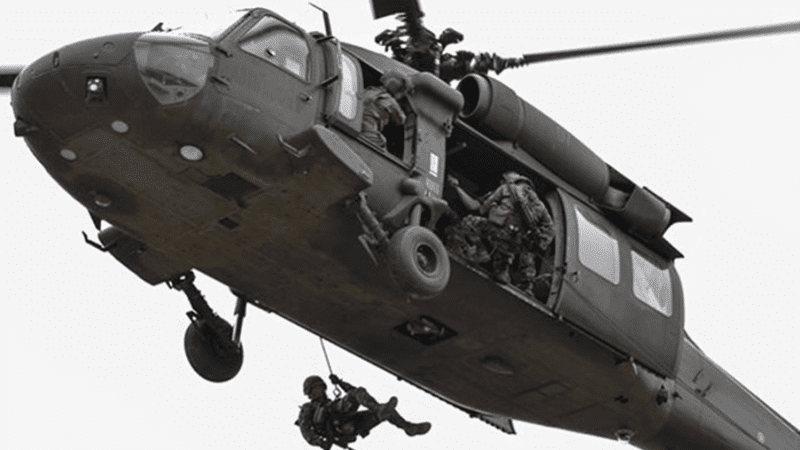Industry
The War in Ukraine Underline Helicopter Vulnerability

Photo. Elbit Systems
A wake-up call for Poland to enhance its helicopter protection with miniaturized DIRCM – is the latest technology in helicopter survivability.
A sponsored article, partner of publication Lance&Shield
The War in Ukraine reiterates the battlefield vulnerability of helicopters and lessons are learned there the hard way, at great costs in human lives and essential military hardware. This is a wake-up call for Poland, operating helicopters of the same models, with similar protective measures.
Combat and assault helicopters are essential component of the Russian military power, and the loses they suffered in the first three weeks of the war in Ukraine point to the insufficient protection provided by legacy systems. In the first days of the war Russia have lost at least four Ka-52, four Mi-24/35, two M-8s. This tally is comparable to the combat losses in helicopters coalition forces suffered in Iraq throughout 2003, including the 'Iraqi Freedom' war, where helicopters faced similar threats of MANPADS and small arms fire. Air forces operating helicopters in combat zones have suffered these consequences in Iraq, Afghanistan, Syria, Mali, and Ukraine.
Polish Army Aviation have operated with NATO forces in some of these conflicts. Poland operates Mi-8/17 and Mi-24 types, along with locally built modern S-70s black hawks and W-3M Sokol. Most types employ the legacy MANPADS protection systems comprised of a combination of missile launch warning and flare dispensers, similar to what the Russians use on their helicopters.

Photo. IAF
Since then, unmanned aerial vehicles have become a premier reconnaissance and fire support asset, replacing the vulnerable light helicopters. But on other missions, including medical evacuation (MEDEVAC), air assault, combat search and rescue, helicopters are still unreplaceable for their speed, agility, versatility, and payload carrying capability.
Helicopters gunships, such as the Mi-24/35, AH-64, AH-1Z, and A-129, are built to withstand battlefield hardships; they are equipped with different weapons, enabling them to endure prolonged battles. They have multiple layers of defense designed to meet the threat of small arms, and man-portable air defense missile systems (MANPADS) are considered the primary enemy of such helicopters.
Such defenses include the armoring of vulnerable areas on the aircraft, adding heat deflectors to mask the engine exhausts and reduce its vulnerability to thermal sensors. Flare dispensers releasing pyrotechnic decoys are used to deflect heat-seeking missiles away from the platform. But these defenses are not sufficient to defend combat helicopters against modern threats. As for assault helicopters, unlike gunships, assault helicopters such as the UH-60 and Mi-8 are less protected and usually carry only the flare dispensers for self-defense.
While these defenses were adequate against MANPADS of the early generation, modern threats pose an increased threat level, as reflected in the War in Ukraine. The expansive fighting put helicopters at greater risk as flares rapidly deplete when the helicopters are frequently exposed to threats. Such extensive combat use requires a more efficient and long-lasting means of protection, provided by the directional infrared countermeasures (DIRCM). Used as the primary line of defense, DIRCM could defeat MANPADS upon their detection, providing the helicopter a defensive shield throughout the mission, wherever they might face MANPADS ambushes, not only over the contested target areas.
The DIRCM has been available for more than a decade. Still, until now, they were deployed primarily on high-value assets, such as large transport aircraft, head of state and VVIP planes, in Poland, France and Israel, Special Operations Forces transports, and aerial tankers, all are already protected by DIRCM from Elbit Systems. Facing the grim lessons of the War in Ukraine, NATO forces and particularly Poland, should consider beefing up their helicopter defenses with DIRCM.

Photo. Elbit Systems
The directional countermeasures were initially developed for large platforms, while smaller, omnidirectional IR countermeasures were developed for helicopters. These were heavy, power-hungry, and expensive devices. The new generation of laser-based countermeasures introduce a new era for DIRCM. Systems developed by companies like Northrop Grumman and Elbit Systems provides air forces, armies and navies advanced laser based DIRCMs to protect their most valuable aerial assets. Miniaturized DIRCMS have matured and certified on dozens of aircraft and helicopters. Those systems have shrunk in size and improved performance, using a combination of threat detection capabilities and a comprehensive range of countermeasure techniques, enabling the systems to adapt to changing threats quickly. Sealed inside a hyper-hemispherical dome for maximum coverage, such systems pack a powerful fiber laser and gimbaled mirror assemblies for efficient operation. The system rely on an integral thermal camera for accurate target acquisition and tracking.
Examples of such a DIRCMs are the AN/AAQ-24 large aircraft infrared countermeasures system (LAIRCM) from Northrop Grumman integrated on most of the US Air Force and Naval Air Forces' large jets. Typical platforms include the US Air Force C-5, C-17, C-37, and C-40 cargo and utility jets; Air Force C-130H and MC-130W tactical transport planes, the CV-22 tiltrotor aircraft, the KC-46 aerial refueling jet, and the U.S. Navy P-3 maritime patrol jet. LAIRCM also can fit on some large military helicopters such as the CH-53K and SOCOM's heavy choppers.
Elbit Systems' MUSIC family has been operational with several NATO air forces for more than a decade. Among MUSIC users are the Israel Air Force, German Air Force, the European Multinational Multi-Role Tanker, Transport Fleet (MMF), and the United Arab Emirates Air Force. The C-MUSIC system has been integrated on head-of-state aircraft, including three Boeing Next-Generation 737 airplanes serving as the head-of-state aircraft for the Polish president and top government officials. C-MUSIC systems have accumulated tens of thousands of operational flight hours. The smallest family member is Mini MUSIC, weighing only 19-kg. It is designed to protect small and medium platforms such as assault and transport helicopters operating in a combat zone. Mini MUSIC can be integrated with various generations of missile warning systems (MWS).
In retrospect of recent conflicts, reiterated by the hard lessons learned by the Russians in Ukraine, military helicopter operators should invest in upgrading the protection of combat and assault helicopter sent into combat. Unlike adding flares, or beefing-up armor, DIRCM introduces a modern, proven, and mature technology that adds a new defensive layer to enhance the helicopter's protection against unexpected threats. After all, air crews risking their lives in combat missions and lifesaving MEDEVAC deserve the same protection provided for the VVIP and head of state.
A sponsored article, partner of publication Lance&Shield
